 Archaeologists excavating the archeological site of Vetulonia outside of Grosseto, Tuscany, have found a remarkably intact Etruscan house dating to between the 3rd and 1st centuries B.C. Most of the standing structure appears to have been a basement used for food storage. You can still see the family’s earthenware grain storage pot and olive press in the corner. The team also found all kinds of pottery, vessels, plates which although broken are complete enough to be put back together for display.
Archaeologists excavating the archeological site of Vetulonia outside of Grosseto, Tuscany, have found a remarkably intact Etruscan house dating to between the 3rd and 1st centuries B.C. Most of the standing structure appears to have been a basement used for food storage. You can still see the family’s earthenware grain storage pot and olive press in the corner. The team also found all kinds of pottery, vessels, plates which although broken are complete enough to be put back together for display.
The original beaten clay floor are intact, and the sun-baked clay bricks used to build the walls are the first Etruscan bricks ever found. The house contained a large number of nails which suggests there was a second floor made from wood and clay, with wooden beams supporting it. The team even found a door knob and the remains of bronze furniture.
“These are the best [Etruscan] ruins that have ever been found in Italy,” said Simona Rafanelli, director of the Isidoro Falchi archeological museum in Vetulonia, told journalists.
“They represent something incredibly important from an archeological and historical point of view, because they finally give us an understanding of new techniques linked to Etruscan construction that we did not know until today.
“Here today we are rewriting history. It is a unique case in Italy because with what we have found we will be able to completely reconstruct the entire house.”
Etruscan and Roman coins found in the house date the collapse of the building to 79 B.C., the year after dictator Lucius Cornelius Sulla’s retired as leader of Rome after years of war and bloody proscriptions. Vetulonia is known to have been in the thick of Sulla’s wars during those years.
It was an important Etruscan center in its heyday. According to 1st century epic poet Silius Italicus, the fasces, Roman Republican symbol of authority, were introduced to Rome from Vetulonia. By the time this domus was built, however, the town had begun to fade into obscurity.
For more pictures of the find, see this slideshow from Italian newspaper, La Repubblica.